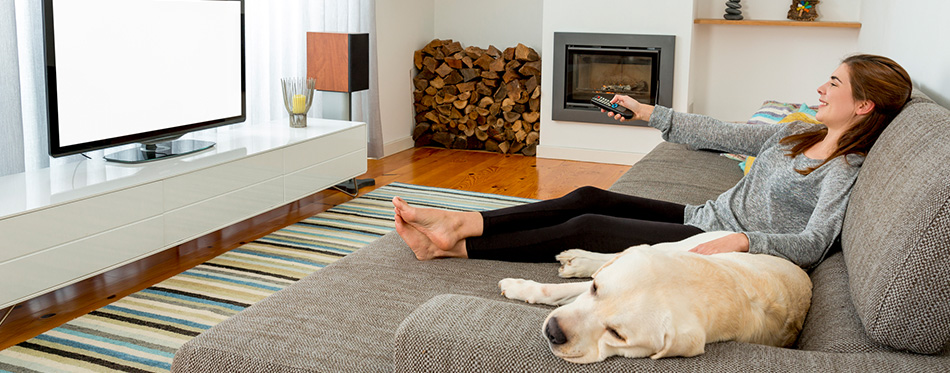Television is one of the most popular forms of entertainment ever to be invented by humans. It is common knowledge that the human species derive a lot of pleasure from watching TV, but are they the only ones? If you have a pet, it is natural that you would want them to participate in the things you love doing. Have you ever slumped in your sofa to watch a show with your pooch by your side? Ever wondered what might be going through your dog’s mind while it is fixated on the TV? In the first place, have you ever asked yourself ‘can dogs see TV?’ You are not alone in wondering these things, and studies have been conducted to understand the processes that occur whenever a dog watches TV. In this article, a critical look will be taken into the interaction between dogs and screens and whether they are as interested as humans are. Some of the already mentioned questions will be answered alongside others like ‘can dogs see screens?’.

How Do Dogs See TV?
- Since humans are capable of reasoning, they can distinguish three-dimensional images from two-dimensional ones. This phenomenon is known as depth perception and it starts with the retina. Dogs, on the other hand, experience something similar, which is referred to as depth sensation. This is a means by which they locate things they have seen and is facilitated by the evolutionary adaptation called binocular vision. Canines experience binocular overlap where both ocular convergent and divergent work together and help the dog realize that the object is not present. This causes the dog to fixate on the images on the television without distorting their curiosity.
- Dogs also have a field of view, which is described as how separate images are viewed along the visual plane. The field of view dogs have is narrow, since they are predators and so they solely rely on their binocular vision or depth sensation. They have a field of view of 240 degrees maximum, which can attract some breeds of dogs to a moving object. They may lose interest very quickly once they notice there isn’t anything happening there.
- Dogs are good at detecting motion due to their eye or retina structure to be more precise. Unlike humans, dogs have lesser cones in their eyes and so are sensitive to low light situations. This characteristic makes it easy for dogs to notice movement further away than stationary objects close by. This shows that they are capable of seeing the action going on on the TV even though they might not be sure about the details. They will more likely pay much attention once their curiosity is peaked satisfactorily.
- Canines see things differently than humans do, and it is explained further by the difference in vision types. Dogs are also described to have dichromatic vision, which allows them to see in two spectrums of light as opposed to a multichromatic view in humans. Their eyes are equipped with two kinds of color receptor cells that let them see in blue and yellow. This means that the chance of your dog noticing what is going on in the TV is high since these two colors are bound to be present.
- Dogs have eyes that register images faster than humans, and so they can determine more quickly whether they are interested or not. They view television in fast forward and so an old TV set will look like flickering images to them. Because dogs see pictures faster, they tend to have shorter interactions with television. This interaction is usually under three seconds and everything after that is a fixation. They will stare rather than focus on the action going on as humans do. This is proven in a study where dogs were presented with three screens and they fixated on one regardless of what was on it.
Do Dogs Enjoy Watching TV?
This question is a tough one to answer because it is hard to tell what dogs are feeling internally when they watch TV. However, studies have shown that dogs do react to television images which are an indicator that they are aware of what is going on. First of all, it is known that some breeds of dogs are more likely to react to television action than others. For example, hounds are more interested in smells while herding dogs like terriers a moved by visuals. This means that the herding breed is more likely to be involved in a television program than hounds. The personality of the dog can also be a factor in whether they will react to the television or not.
Furthermore, studies have shown that dogs are more likely to respond to the television when there is another dog on it. This comes off the back of the fact that dogs can recognize faces that look like theirs and distinguish it from others like humans. The reaction is reinforced when the sounds accompanying the images resemble dog sounds like barking. Furthermore, sounds are known to yield more responses out of a dog than just pictures. The watching dog might bark in response and run to the back to the television set to find the other dog.

To Summarize
It is not far-fetched to have your dog watching TV and it can serve as bonding time for you and your pet. But sometimes it gets fascinating to think that your dog understands what is going on on the television. The curiosity of the human species has led them to find out how dogs perceive television and in what ways is their view differs. Though some of the explanations are not concrete, the biological basis provides an understanding of the process. It is unclear whether dogs enjoy television but it is evident by their reactions that they can understand what is going on. Clearly, dogs have a separate experience of watching TV than humans but each species also derives some benefit out of it.
Sources:
- Can Dogs See TV? – PetMD
- Why Does My Dog Watch TV? – AKC

